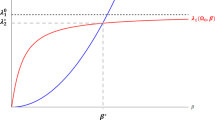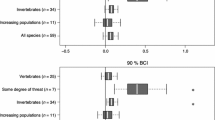Abstract
We examine the classical problem of the existence of a threshold size for a patch to allow for survival of a given population in the case where the patch is not completely isolated. The surrounding habitat matrix is characterized by a non-zero carrying capacity. We show that a critical patch size cannot be strictly defined in this case. We also obtain the saturation density in such a patch as a function of the size of the patch and the relative carrying capacity of the outer region. We argue that this relative carrying capacity is a measure of the isolation of the patch. Our results are then compared with conclusions drawn from observations of the population dynamics of understorey birds in fragments of the Amazonian forest and shown to qualitatively agree with them, offering an explanation for the importance of dispersal and isolation in these observations. Finally, we show that a generalized critical patch size can be introduced resorting to threshold densities for the observation of a given species.
Similar content being viewed by others
References
Andow D., Kareiva P., Levin S., Okubo A.: Spread of invading organisms. Landsc. Ecol. 4, 177–188 (1990)
Bainbridge R.: The size, shape and density of marine phytoplankton concentrations. Biol. Rev. Camb. Phil. Soc. 32, 91–115 (1957)
Ballard M., Kenkre V.M., Kupperman M.N.: Periodically varying externally imposed environmental effects in population biology. Phys. Rev. E 70, 031912 (2004)
Berestycki H., Hamel F.: Fronts and invasions in general domains. C. R. Acad. Sci. Paris, Ser. I 343, 711–716 (2006)
Cantrell R.S., Cosner C.: On the effects of spatial heterogeneity on the persistence of interacting species. J. Math. Biol. 37, 103–145 (1998)
Cantrell R.S., Cosner C.: The effects of spatial heterogeneity on population dynamics. J. Math. Biol. 29, 315–338 (1991)
Cantrell R.S., Cosner C.: Insular biogeographic theory and diffusion models in population dynamics. Theor. Pop. Biol. 45, 177–202 (1994)
Cantrell R.S., Cosner C., Fagan W.F.: Competitive reversals inside ecological reserves: the role of external habitat degradation. J. Math. Biol. 37, 491–533 (1998)
Fahrig L.: Effects of habitat fragmentation on biodiversity. Ann. Rev. Ecol. Syst. 34, 487–515 (2003)
Ferraz G. et al.: A large scale deforestation experiment: effects of patch area and isolation on amazon birds. Science 315, 238–241 (2007)
Fife P.C.: Mathematical Aspects of reacting and Diffusing Systems. Lecture Notes in Biomath., vol. 28. Springer, Berlin (1979)
Kenkre V.M., Kuperman M.N.: Applicability of Fisher equation to bacterial population dynamics. Phys. Rev. E 67, 051921 (2003)
Kierstaed H., Slobodkin I.B.: The size of water masses containing plankton bloom. J. Marine Research 12, 141–147 (1953)
Latore J., Gould P., Mortimer M.A.: Spatial Dynamics and Critical Patch Size of Annual Plant Populations. J. Theo. Biol. 180, 277–285 (1998)
Lin A.L. et al.: Localization and extinction of bacterial populations under inhomogeneous growth conditions. Bioph. J. 87, 75–80 (2004)
Ludwig D., Aronson D.G., Weinberger H.F.: Spatial patterning of the spruce bud-worm. J. Math. Biol. 8, 217–258 (1979)
MacArthur R.H., Wilson E.O.: Theory of Island Biogeography. Princeton University Press, Princeton (1967)
Martin A.P.: On filament width in oceanic plankton distributions. J. Plankton Res. 22, 597–602 (2000)
Neicu T., Pradhan A., Larochelle D.A., Kudrolli A.: Extinction transition in bacterial colonies under forced convection. Phys. Rev. E 62, 1059–1062 (2000)
Okubo, A., Levin, S.A. (eds.) Diffusion and Ecological Problems, Chap. 9. Springer, Berlin (2001)
Pacala S.W., Roughgarden J.: Spatial heterogeneity and interspecific competition. Theor. Pop. Biol. 21, 91–113 (1982)
Perry N.: Experimental validation of a critical domain size in reaction-diffusion systems with Escherichia coli populations. J. R. Soc. Interface 2, 379–387 (2005)
Sanchez B.C., Parmenter R.R.: Patterns of shrub-dwelling arthropod diversity across a desert shrubland-grassland ecotone: a test of island biogeographic theory. J. Arid. Environ. 50, 247–265 (2002)
Skellam J.: Random dispersal in theoretical populations. Biometrika 38, 196–218 (1951)
Shigesada N., Kawasaki K.: Biological Invasions: Theory and Practice. Oxford University Press, Oxford (1997)
Stouffer P.C., Bierregaard R.O. Jr, Strong R., Lovejoy T.E.: Long-term landscape change and bird abundance in Amazonian rainforest fragments. Conserv. Biol. 20, 1212–1223 (2006)
Author information
Authors and Affiliations
Corresponding author
Rights and permissions
About this article
Cite this article
Artiles, W., Carvalho, P.G.S. & Kraenkel, R.A. Patch-size and isolation effects in the Fisher–Kolmogorov equation. J. Math. Biol. 57, 521–535 (2008). https://doi.org/10.1007/s00285-008-0174-2
Received:
Revised:
Published:
Issue Date:
DOI: https://doi.org/10.1007/s00285-008-0174-2




